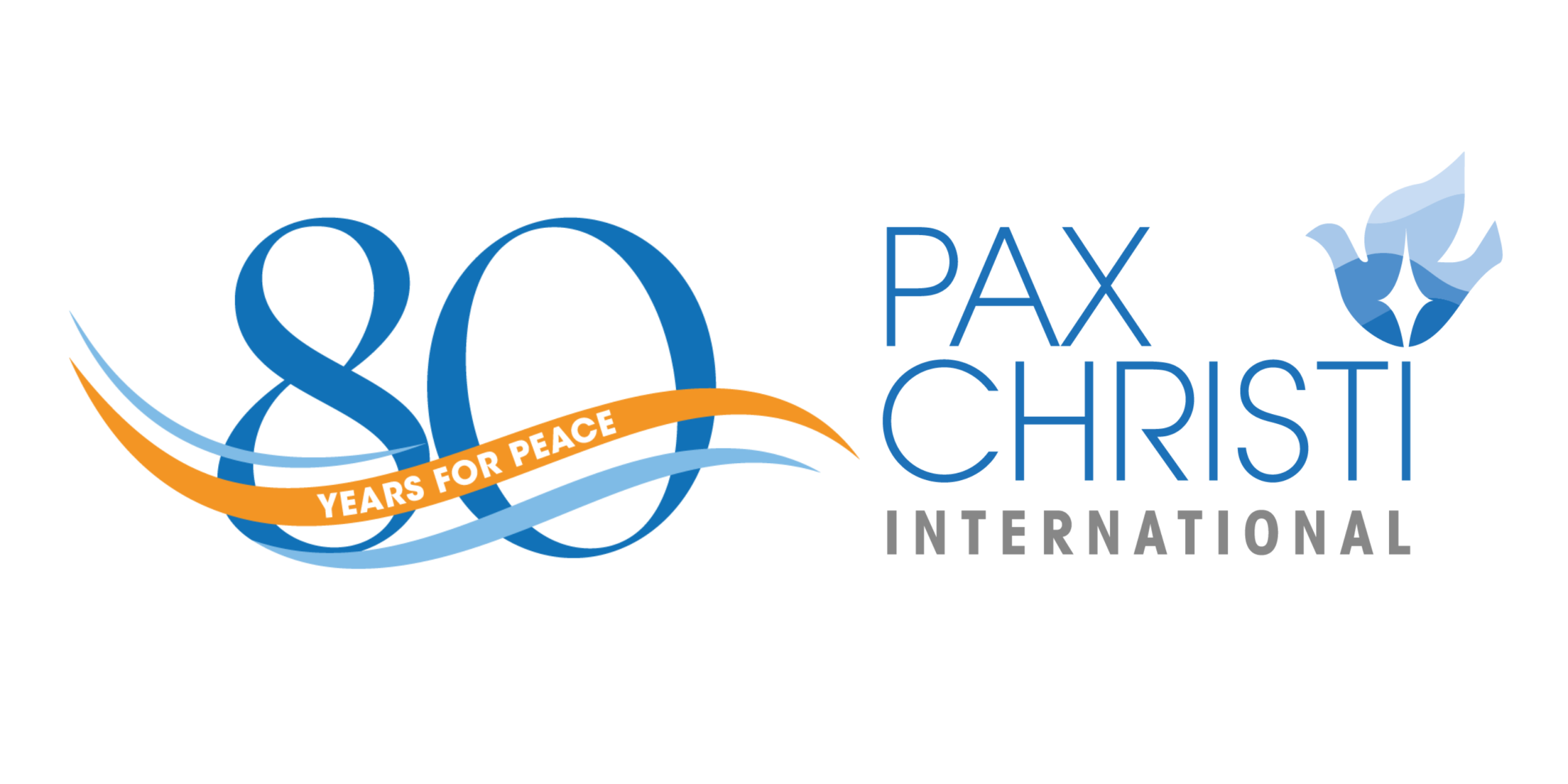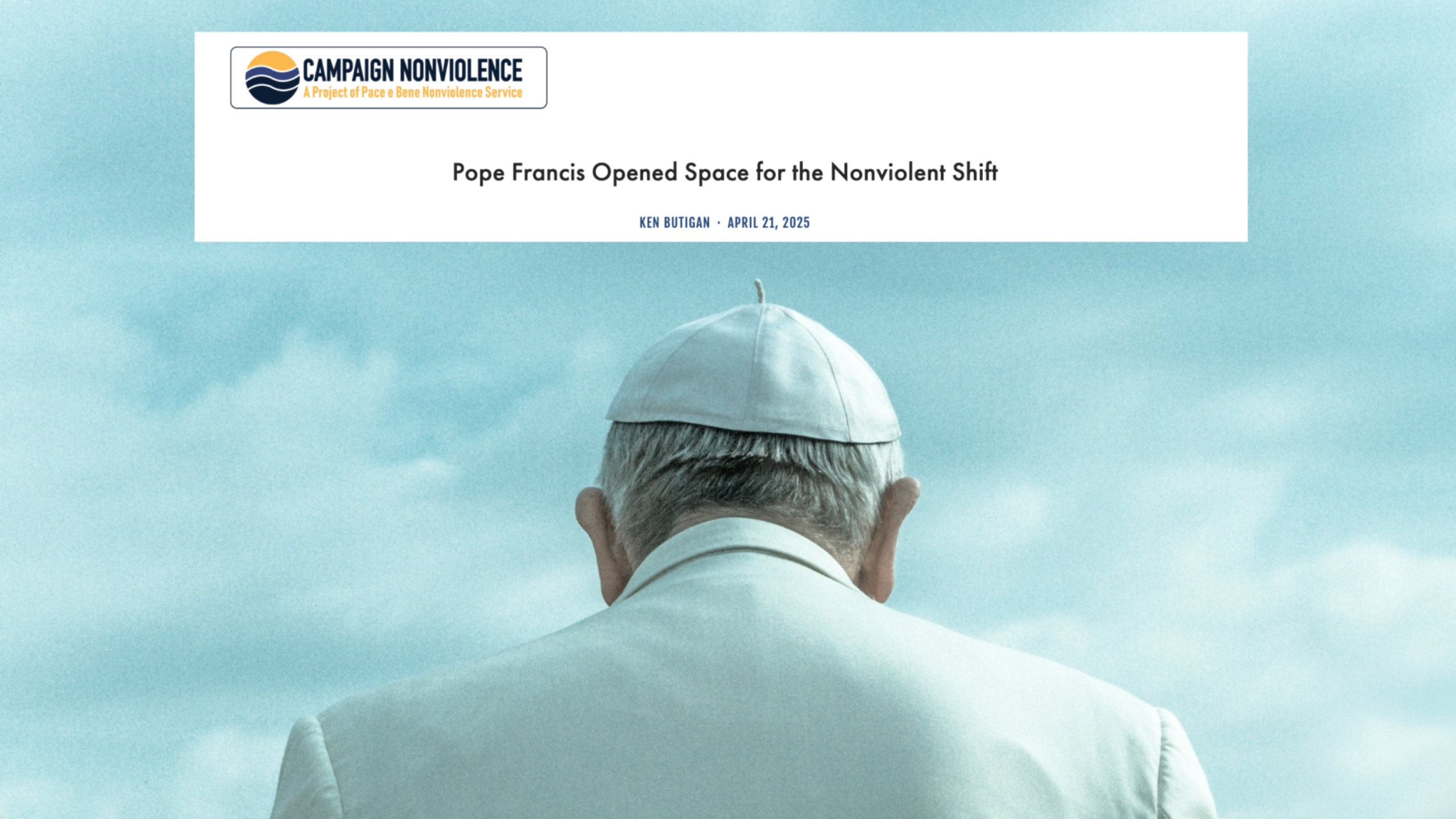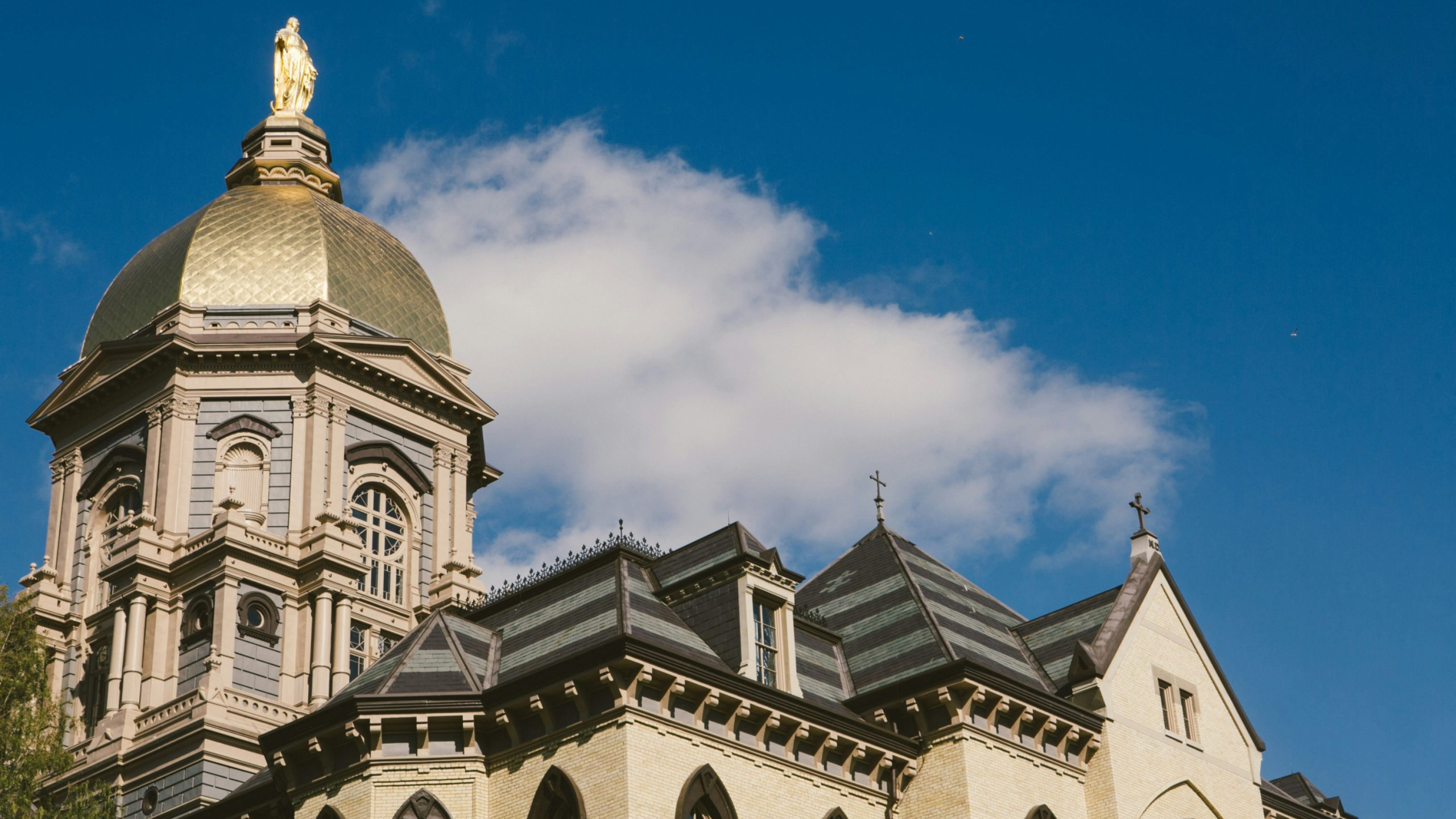By Ken Butigan
In light of the overriding message of peace Pope Leo XIV has shared with the Church and the world throughout his young pontificate, it is clear why his very first words as he stood on the balcony of St. Peter's Basilica were: "Peace be with you all!"
By echoing Jesus' blessing bestowed after the Resurrection on his disciples (Lk 24:3; Jn 20:19), Leo made unmistakably clear that peace is at the heart of the Gospel, peace is at the core of the mission of the Church, and peace will be central to his papacy.
This centrality has been dramatically confirmed almost daily since then.
The cause of peace has incessantly figured in the general audiences, addresses, and statements of the new pontiff. Against the backdrop of mounting war – but also, as he has said, "terrorism, human trafficking, widespread aggression" – Leo has affirmed the late Pope Francis' stalwart call for nonviolent alternatives, while bringing this vision newly forward in his own way, from, for example, comments on athletics ("sport is a way to build peace, because it is a school of respect and loyalty, which increases the culture of encounter"), astrophysics ("through your pursuit of knowledge, each of you can contribute to building a more peaceful and just world") and the work of the media ("Let us disarm words and we will help to disarm the world").
But his call for peace has also, like that of his predecessor, relentlessly denounced the terror of war in Ukraine, Myanmar, Israel, Gaza, Sudan, and other nations. Pope Leo declared, "In today's dramatic scenario of a piecemeal third world war, as Pope Francis stated many times, I too address the world's leaders, repeating the ever-timely appeal: 'Never again war!'" He has also stated, "The wars plaguing our world are a tragic sign of [indifference]. Let us invoke the Spirit of love and peace, that he may open borders, break down walls, dispel hatred and help us to live as children of our one Father who is in heaven." (There are 196 references to war in Pope Leo' addresses and Vatican News reports since his becoming pope.)
But Pope Leo is not simply condemning specific wars. He has emphasized that "we must reject the paradigm of war," indicating that our task in this time is not simply to hope for peace but to "prepare institutions of peace" and to build a "culture of life, dialogue, mutual respect."
In this spirit, he has pointed to nonviolence as key to achieving this alternative paradigm, by emphasizing the need for "witnesses of a different, nonviolent life style" and "credible protagonists of nonviolent processes of peacebuilding."
"Nonviolence as a method and as a style must distinguish our decisions, our relationships, our actions," the pope has declared.
Over the first weeks of his Petrine ministry, Leo has shared with the Church a growing catechesis in the formation of the nonviolent life and of faithful peacemaking, even as he has urged the world to pull back from the brink of horrific violence.
There is much to be learned from Leo's almost daily call for peace and the spirit of nonviolence. We can catch a glimpse of this by focusing on what he shared over three recent days in June.
June 16-18: Advancing Peace and Nonviolence
Over these three days, Pope Leo accelerated his focus on peace by praying for victims of violence in conflicts in Nigeria, Sudan, Myanmar, Ukraine, and the Middle East; by lifting up the memory of African martyr Blessed Floribert Bwana Chui, "an example of faith in God and peacebuilding" who showed how to be "a leaven for peace—unarmed and disarming"; and by declaring, "We must not get used to war! Indeed, we must reject as a temptation the allure of powerful and sophisticated armaments. In the name of human dignity and international law, I repeat to those in charge what Pope Francis used to say: war is always a defeat!"
On top of these powerful prayers and messages, Pope Leo reflected on how the Church can concretely put the call for peace and nonviolence into action in their dioceses and parishes, rooted in the Gospel and the apostolic mission of the Church.
"In a time of great fragmentation," he stated in an address to the bishops of Italy, "it is necessary to return to the foundation of our faith, to the kerygma. The relationship with Christ calls on us to develop a pastoral focus on the theme of peace. Indeed, the Lord sends us into the world to bring his same gift: 'Peace be with you!' and to become its creators in everyday life."
Building on this Gospel foundation, Pope Leo gets more specific:
"I am thinking of parishes, neighborhoods, areas within the country, the urban and existential peripheries. There, where human and social relationships become difficult and conflict takes shape, perhaps subtly, a Church capable of reconciliation must make herself visible. The apostle Paul urges us, "If possible, on your part, live at peace with all" (Rm 12:18); it is an invitation that entrusts a tangible portion of responsibility to every person." Here Pope Leo not only says that the Church's role is to foster reconciliation, but it is also the task of people everywhere to be peacemakers.
But what can be done to make this feasible? The Church, the pope says, needs to foster a nonviolent culture:
"I hope…that every diocese may promote pathways of education in nonviolence, mediation initiatives in local conflicts, and welcoming projects that transform fear of the other into an opportunity for encounter. May every community become a 'house of peace,' where one learns how to defuse hostility through dialogue, where justice is practiced and forgiveness is cherished."
Here Pope Leo stresses the need for formation and education in nonviolence.
If we have not been taught that nonviolence is at the heart of the Gospel, then we won't see that living nonviolently is part of our faith.
If we have not been taught the methods and tools of nonviolence – like conflict resolution, de-escalation tactics, nonviolent communication, restorative justice circles, mediation, and trauma healing – we'll probably fall back on approaches that simply avoid, accommodate, appease, or attack.
If we have not been taught the methods and tools of nonviolent social change – like civil resistance, movement-building, civilian-based defense, or unarmed civilian protection — we will likely rely on traditional scripts like counter-violence or staying passive.
Finally, if we have not been taught that nonviolence is core to the Gospel and the calling of a Christian –putting down our sword, overcoming good with evil, intervening nonviolently, becoming peacemakers – then we're likely to believe that violence is the answer to the conflicts we face.
Pope Leo counsels us to foster every community as a "house of peace": defusing violence, learning to forgive one another, and "cultivating a culture of dialogue." As he says, "It is good for all ecclesial realities—parishes, associations and movements—to be spaces of intergenerational listening, of comparison with different worlds, of caring about words and relationships. Because only where there is listening can communion be born, and only where there is communion does truth become credible."
"The proclamation of the Gospel, peace, human dignity, dialogue: these are the coordinates through which you can be a Church that incarnates the Gospel and is a sign of the Kingdom of God," Pope Leo teaches.
In this way we can be a nonviolent synodal Church, where "synodality becomes a mindset, in the heart, in decision-making processes and in ways of acting." In this spirit, he calls on the bishops to "take care that the lay faithful, nourished with the Word of God and formed in the social doctrine of the Church, are agents of evangelization in the workplace, in schools, in hospitals, in social and cultural environments, in the economy, and in politics."
In just a few short paragraphs, Pope Leo XIV has sketched a vision of a culture of nonviolence that the Church can nourish concretely in the midst of the challenges and realities of this wounded world.
As he said, "Peace is not a spiritual utopia: it is a humble path, made up of daily gestures that interweave patience and courage, listening and action, and which demands today, more than ever, our vigilant and generative presence."
In the first days of his pontificate, Pope Leo is teaching us anew how nonviolence—defusing violence, dispelling hatred, returning to the foundations of our faith, and living "unarmed and disarming"—is the way to peace at the heart of the Gospel. Now is the time, His Holiness seems to be saying, to build a culture of nonviolence and peace in the Church and the world.
Ken Butigan is a Senior Advisor to the Catholic Institute for Nonviolence and the catholic Nonviolence Initiative. He is a professor at DePaul University in Chicago, USA, in the Peace, Justice and Conflict Studies Program.
Explore other articles by Ken Butigan
Cover Picture via Vatican News©
By Ken Butigan
In light of the overriding message of peace Pope Leo XIV has shared with the Church and the world throughout his young pontificate, it is clear why his very first words as he stood on the balcony of St. Peter's Basilica were: "Peace be with you all!"
By echoing Jesus' blessing bestowed after the Resurrection on his disciples (Lk 24:3; Jn 20:19), Leo made unmistakably clear that peace is at the heart of the Gospel, peace is at the core of the mission of the Church, and peace will be central to his papacy.
This centrality has been dramatically confirmed almost daily since then.
The cause of peace has incessantly figured in the general audiences, addresses, and statements of the new pontiff. Against the backdrop of mounting war – but also, as he has said, "terrorism, human trafficking, widespread aggression" – Leo has affirmed the late Pope Francis' stalwart call for nonviolent alternatives, while bringing this vision newly forward in his own way, from, for example, comments on athletics ("sport is a way to build peace, because it is a school of respect and loyalty, which increases the culture of encounter"), astrophysics ("through your pursuit of knowledge, each of you can contribute to building a more peaceful and just world") and the work of the media ("Let us disarm words and we will help to disarm the world").
But his call for peace has also, like that of his predecessor, relentlessly denounced the terror of war in Ukraine, Myanmar, Israel, Gaza, Sudan, and other nations. Pope Leo declared, "In today's dramatic scenario of a piecemeal third world war, as Pope Francis stated many times, I too address the world's leaders, repeating the ever-timely appeal: 'Never again war!'" He has also stated, "The wars plaguing our world are a tragic sign of [indifference]. Let us invoke the Spirit of love and peace, that he may open borders, break down walls, dispel hatred and help us to live as children of our one Father who is in heaven." (There are 196 references to war in Pope Leo' addresses and Vatican News reports since his becoming pope.)
But Pope Leo is not simply condemning specific wars. He has emphasized that "we must reject the paradigm of war," indicating that our task in this time is not simply to hope for peace but to "prepare institutions of peace" and to build a "culture of life, dialogue, mutual respect."
In this spirit, he has pointed to nonviolence as key to achieving this alternative paradigm, by emphasizing the need for "witnesses of a different, nonviolent life style" and "credible protagonists of nonviolent processes of peacebuilding."
"Nonviolence as a method and as a style must distinguish our decisions, our relationships, our actions," the pope has declared.
Over the first weeks of his Petrine ministry, Leo has shared with the Church a growing catechesis in the formation of the nonviolent life and of faithful peacemaking, even as he has urged the world to pull back from the brink of horrific violence.
There is much to be learned from Leo's almost daily call for peace and the spirit of nonviolence. We can catch a glimpse of this by focusing on what he shared over three recent days in June.
June 16-18: Advancing Peace and Nonviolence
Over these three days, Pope Leo accelerated his focus on peace by praying for victims of violence in conflicts in Nigeria, Sudan, Myanmar, Ukraine, and the Middle East; by lifting up the memory of African martyr Blessed Floribert Bwana Chui, "an example of faith in God and peacebuilding" who showed how to be "a leaven for peace—unarmed and disarming"; and by declaring, "We must not get used to war! Indeed, we must reject as a temptation the allure of powerful and sophisticated armaments. In the name of human dignity and international law, I repeat to those in charge what Pope Francis used to say: war is always a defeat!"
On top of these powerful prayers and messages, Pope Leo reflected on how the Church can concretely put the call for peace and nonviolence into action in their dioceses and parishes, rooted in the Gospel and the apostolic mission of the Church.
"In a time of great fragmentation," he stated in an address to the bishops of Italy, "it is necessary to return to the foundation of our faith, to the kerygma. The relationship with Christ calls on us to develop a pastoral focus on the theme of peace. Indeed, the Lord sends us into the world to bring his same gift: 'Peace be with you!' and to become its creators in everyday life."
Building on this Gospel foundation, Pope Leo gets more specific:
"I am thinking of parishes, neighborhoods, areas within the country, the urban and existential peripheries. There, where human and social relationships become difficult and conflict takes shape, perhaps subtly, a Church capable of reconciliation must make herself visible. The apostle Paul urges us, "If possible, on your part, live at peace with all" (Rm 12:18); it is an invitation that entrusts a tangible portion of responsibility to every person." Here Pope Leo not only says that the Church's role is to foster reconciliation, but it is also the task of people everywhere to be peacemakers.
But what can be done to make this feasible? The Church, the pope says, needs to foster a nonviolent culture:
"I hope…that every diocese may promote pathways of education in nonviolence, mediation initiatives in local conflicts, and welcoming projects that transform fear of the other into an opportunity for encounter. May every community become a 'house of peace,' where one learns how to defuse hostility through dialogue, where justice is practiced and forgiveness is cherished."
Here Pope Leo stresses the need for formation and education in nonviolence.
If we have not been taught that nonviolence is at the heart of the Gospel, then we won't see that living nonviolently is part of our faith.
If we have not been taught the methods and tools of nonviolence – like conflict resolution, de-escalation tactics, nonviolent communication, restorative justice circles, mediation, and trauma healing – we'll probably fall back on approaches that simply avoid, accommodate, appease, or attack.
If we have not been taught the methods and tools of nonviolent social change – like civil resistance, movement-building, civilian-based defense, or unarmed civilian protection — we will likely rely on traditional scripts like counter-violence or staying passive.
Finally, if we have not been taught that nonviolence is core to the Gospel and the calling of a Christian –putting down our sword, overcoming good with evil, intervening nonviolently, becoming peacemakers – then we're likely to believe that violence is the answer to the conflicts we face.
Pope Leo counsels us to foster every community as a "house of peace": defusing violence, learning to forgive one another, and "cultivating a culture of dialogue." As he says, "It is good for all ecclesial realities—parishes, associations and movements—to be spaces of intergenerational listening, of comparison with different worlds, of caring about words and relationships. Because only where there is listening can communion be born, and only where there is communion does truth become credible."
"The proclamation of the Gospel, peace, human dignity, dialogue: these are the coordinates through which you can be a Church that incarnates the Gospel and is a sign of the Kingdom of God," Pope Leo teaches.
In this way we can be a nonviolent synodal Church, where "synodality becomes a mindset, in the heart, in decision-making processes and in ways of acting." In this spirit, he calls on the bishops to "take care that the lay faithful, nourished with the Word of God and formed in the social doctrine of the Church, are agents of evangelization in the workplace, in schools, in hospitals, in social and cultural environments, in the economy, and in politics."
In just a few short paragraphs, Pope Leo XIV has sketched a vision of a culture of nonviolence that the Church can nourish concretely in the midst of the challenges and realities of this wounded world.
As he said, "Peace is not a spiritual utopia: it is a humble path, made up of daily gestures that interweave patience and courage, listening and action, and which demands today, more than ever, our vigilant and generative presence."
In the first days of his pontificate, Pope Leo is teaching us anew how nonviolence—defusing violence, dispelling hatred, returning to the foundations of our faith, and living "unarmed and disarming"—is the way to peace at the heart of the Gospel. Now is the time, His Holiness seems to be saying, to build a culture of nonviolence and peace in the Church and the world.
Ken Butigan is a Senior Advisor to the Catholic Institute for Nonviolence and the catholic Nonviolence Initiative. He is a professor at DePaul University in Chicago, USA, in the Peace, Justice and Conflict Studies Program.
Explore other articles by Ken Butigan
Cover Picture via Vatican News©






Leave A Comment